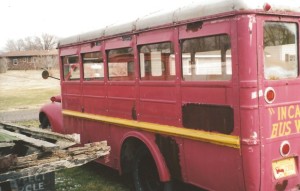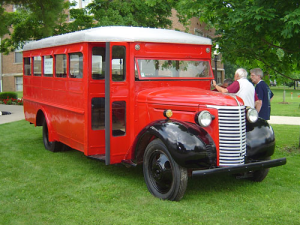- The January 1986 issue of Indianapolis Monthly named Maris Valainis (Jimmy Chitwood) one of “86 people to watch in ’86.”
- On the last weekend of September 1986, the town of New Richmond held the first of five annual Hickory Festivals.
- At the beginning of 1987, after Hoosiers had been playing in Indiana for seven weeks, the parents of Steve Hollar (Hickory Husker Rade) had seen the movie nine times.
- To celebrate the nationwide release, at the end of February 1987 the movie theater in the hometown of Hickory Husker Brad Long (Buddy) threw a party as it showed Hoosiers for the 483rd time. At Greenwood Cinema, Long was awarded a statuette reminiscent of an Oscar for Best Performance by a Greenwood Resident in a Major Motion Picture.
- In the spring of 1987, an article in the Fort Wayne (IN) Journal-Gazette predicted that fame wouldn’t last for Hollar. However, to this day he is often recognized as having been in the movie (as are the other Huskers).
- When Hoosiers was released on VHS on September 9, 1987 by HBO Video, Inc., it cost $89.95. VHS tapes of the film were temporarily pulled from store shelves in October when Vestron Video claimed that it, not HBO, owned the rights to distribute Hoosiers on VHS. This disagreement also delayed the VHS release of Platoon. The issue was settled in Vestron’s favor the following January.
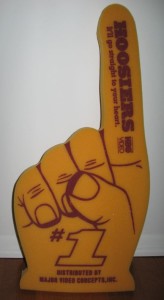 A “We’re number one” foam finger was made as a promotional item for the videotape release.
A “We’re number one” foam finger was made as a promotional item for the videotape release.- In February 1988, Hoosiers was one of the movies shown at Moscow’s first-ever American film festival. Featured were 30 movies never before seen in the Soviet Union, including King’s Row, The Wizard of Oz, and The Empire Strikes Back.
- In May 1989, Gene Hackman sued Hemdale Film Corporation and HBO. He claimed they owed him more than $500,000 in profits from sales of the videocassette. He also asked for $5 million in punitive damages. The suit was settled that December for an undisclosed sum.
- New Richmond’s final annual Hickory Festival was held September 28–30, 1990. Writer/producer Angelo Pizzo and director David Anspaugh attended, along with most of the Huskers, the cheerleaders, and some extras. Film editor Tim O’Meara presented a 3½-hour-long uncut version of the movie.
- An article in the November 19, 1990 issue of Sports Illustrated compared former Indiana high school basketball star and IU freshman Damon Bailey to Jimmy Chitwood. It also likened Bailey’s high school team, the Bedford North Lawrence Stars, to the Huskers; BNL had won the state championship earlier that year.
- The same article described Hoosiers as “a quaint offering on late-night pay cable.”
- The Heartland Film Festival in Indianapolis celebrated Hoosiers’ 10th anniversary in 1996. Pizzo and Anspaugh attended.
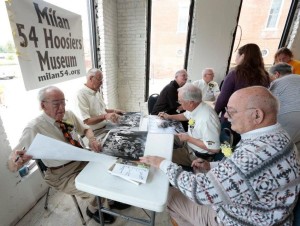 The story of the 1954 Milan Miracle team hasn’t been forgotten. In 1999, Sports Illustrated named the 1954 Milan Indians one of the top 20 teams of the century. Five years later, the Indiana General Assembly passed a resolution honoring the team on the 50th anniversary of its state championship. The town of Milan has a museum dedicated to the team.
The story of the 1954 Milan Miracle team hasn’t been forgotten. In 1999, Sports Illustrated named the 1954 Milan Indians one of the top 20 teams of the century. Five years later, the Indiana General Assembly passed a resolution honoring the team on the 50th anniversary of its state championship. The town of Milan has a museum dedicated to the team.- In the Indianapolis Star on April 9, 2001, film critic Bonnie Britton encouraged readers to write to the Library of Congress and suggest that Hoosiers be added to the 12-year-old National Film Registry. Movies named to this list were deemed culturally, historically, or aesthetically significant and thus worthy of preservation. Britton’s suggestion worked, as Hoosiers was named to the registry in December of that year. An official with the Library of Congress confirmed that the institution had received many nomination letters for Hoosiers from all over Indiana, including from a group of students in Milan. Of the almost 1,000 films that were nominated for the registry in 2001, only 25 were chosen.
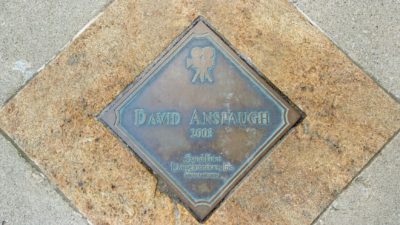 Director David Anspaugh’s name was placed in the sidewalk outside the Embassy Theatre in Fort Wayne, Indiana in 2003. The Embassy’s Walk of Recognition is similar in concept to Hollywood’s Walk of Fame. Each bronze diamond in the sidewalk recognizes someone with a Fort Wayne connection who has achieved outstanding success in the arts. Anspaugh grew up in nearby Decatur.
Director David Anspaugh’s name was placed in the sidewalk outside the Embassy Theatre in Fort Wayne, Indiana in 2003. The Embassy’s Walk of Recognition is similar in concept to Hollywood’s Walk of Fame. Each bronze diamond in the sidewalk recognizes someone with a Fort Wayne connection who has achieved outstanding success in the arts. Anspaugh grew up in nearby Decatur.- Pizzo relocated from Ojai, California to Bloomington, Indiana, his hometown, in 2004. There he continued writing screenplays. He said that, although he had lived in the Los Angeles area for over 30 years, he never felt at home there.
- When the Collector’s Edition DVD of Hoosiers was released in 2005, Anspaugh and Pizzo held an autograph session at IU’s Assembly Hall, where fans were lined up out the door.
-
The year after Hoosiers was filmed, the owner of the movie’s team bus, Jack Baker, decided to sell the bus because he was moving out of state. Ten years later, Baker’s grandson, Darryll Baker, tracked down and went to visit the bus’s owner in New Ross. He found the 56-year-old vehicle in bad shape. It was inoperable. The windows were nearly opaque, and the bus was inhabited by rats, mice, and birds. It needed new wiring and lighting, as well as body and mechanical work. Daryll purchased the bus and hired two men to completely restore it. In 2010, he drove it in Knightstown’s Hoosiers 25th anniversary parade.
- When the Butler Bulldogs reached the Final Four and then the final game of the NCAA men’s basketball tournament in 2010, many people found similarities between the Bulldogs and the Huskers. Butler was the smallest school to reach the NCAA’s final game since the tourney expanded to 64 teams in 1985. The Bulldogs had never progressed this far in the tourney. Their opponent in the final game was Duke, who had captured the NCAA title three times before. And the Bulldogs’ home court was Hinkle Fieldhouse, the filming location of the Huskers’ state championship game in Hoosiers. At one point during the broadcast of the championship game, music from the Hoosiers soundtrack was played over images of the Bulldogs for the TV audience. However, unlike the Huskers, the Bulldogs lost, falling to Duke 61-59. But the Hoosiers references didn’t end in that year. On January 19, 2013, when Butler forward Roosevelt Jones launched a floater with one-tenth of a second left on the clock to defeat Gonzaga, again sportswriters recalled Hoosiers. Gaining a reputation for pulling off unlikely, heart-stopping, last-second victories, the Bulldogs probably have been compared to the Huskers more often than any other team.
- New Richmond resident Roger Kunkel said that, sometimes when tourists visit his town, after walking through the downtown, they ask to be directed to the school and gym used in the filming, assuming they must be just blocks away.
- Ray Craft, a member of the 1954 Indiana state champion Milan Indians, ended up working for the Indiana High School Athletic Association (IHSAA). One day many years ago he received a call from a Hoosiers fan in another state who was planning a trip to Indiana and who wanted to visit the Hoosiers filming locations. The fan wanted to know where he could find the town of Hickory, because he had been unable to locate it on a map.
- Assistant directors Herb Adelman and Harvey Waldman said that, of all the movies they’ve worked on, Hoosiers is one of their favorites.
- Waldman said helping organize, oversee, and pull off the final game scenes at Hinkle Fieldhouse, with five cameras and thousands of extras, was the proudest moment of his career as a second AD.
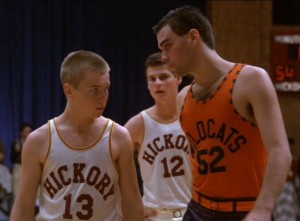 Despite speaking only one line in the film and appearing in only one game, Jeff Moster, the Linton player who is mean to Ollie in the regional game, still is occasionally recognized by Hoosiers fans today.
Despite speaking only one line in the film and appearing in only one game, Jeff Moster, the Linton player who is mean to Ollie in the regional game, still is occasionally recognized by Hoosiers fans today.- Whenever Maris Valainis (Jimmy Chitwood) plays pickup basketball, he notices that his opponents work extra hard to guard him and not leave him open.
- Husker Wade Schenck (Ollie) said that if he had known how huge the movie would become, he most likely never would have auditioned.
- In December 2012, Intrada began selling the Hoosiers soundtrack. This was the first time Jerry Goldsmith’s Oscar-nominated score had been released on CD in the U.S.
 On the afternoon of March 20, 2013, Hoosiers director Anspaugh returned to the Hoosier Gym in Knightstown, Hickory’s home court, for the first time in over 27 years. An emotional Anspaugh marveled at how little the gym has changed over time and how well preserved it is. In front of a handful of onlookers, he related stories from the filming, posed for photos, signed autographs, and shot a few baskets—the final one using Ollie’s awkward underhand shooting style.
On the afternoon of March 20, 2013, Hoosiers director Anspaugh returned to the Hoosier Gym in Knightstown, Hickory’s home court, for the first time in over 27 years. An emotional Anspaugh marveled at how little the gym has changed over time and how well preserved it is. In front of a handful of onlookers, he related stories from the filming, posed for photos, signed autographs, and shot a few baskets—the final one using Ollie’s awkward underhand shooting style. That evening, Anspaugh (on right in photo) and writer/producer Pizzo (on left in photo) were inducted into the Indiana Basketball Hall of Fame. Reflecting on this honor, Pizzo commented, “I never made my varsity team in basketball. I suppose if I had, and had an outstanding career, maybe I wouldn’t have ever written about basketball.” Anspaugh, who lettered three years on his unsuccessful high school basketball team, said, “My coach is probably spinning in his grave right now, thinking, ‘Anspaugh is in the Indiana Basketball Hall of Fame?! You gotta be kidding me!’ My senior year we were 2 and 17!” He further remarked, “I said to Angelo, ‘Can you imagine two guys from Indiana being inducted into the Hall of Fame and not one sectional championship between us?’” (Sources: “Indiana Basketball Hall of Fame Inducts ‘Hoosiers’ Creators,” Network Indiana, March 20, 2013; Kyle Neddenriep, Indystar.com, March 20, 2013; WANE-TV, March 20, 2013)
That evening, Anspaugh (on right in photo) and writer/producer Pizzo (on left in photo) were inducted into the Indiana Basketball Hall of Fame. Reflecting on this honor, Pizzo commented, “I never made my varsity team in basketball. I suppose if I had, and had an outstanding career, maybe I wouldn’t have ever written about basketball.” Anspaugh, who lettered three years on his unsuccessful high school basketball team, said, “My coach is probably spinning in his grave right now, thinking, ‘Anspaugh is in the Indiana Basketball Hall of Fame?! You gotta be kidding me!’ My senior year we were 2 and 17!” He further remarked, “I said to Angelo, ‘Can you imagine two guys from Indiana being inducted into the Hall of Fame and not one sectional championship between us?’” (Sources: “Indiana Basketball Hall of Fame Inducts ‘Hoosiers’ Creators,” Network Indiana, March 20, 2013; Kyle Neddenriep, Indystar.com, March 20, 2013; WANE-TV, March 20, 2013)- In 2014, Pizzo estimated that he has written about 25 screenplays.
- Anspaugh relocated to Bloomington, Indiana in the summer of 2014. He has directed and acted in plays and has taught a class in directing for film and TV at Indiana University. When Anspaugh enrolled in film school at the University of Southern California in the mid-1970s, his career goal at that time was to become a professor.
- In the summer of 2014, Pizzo tackled his first motion-picture directing assignment as he helmed college-football biopic My All American. Directing a movie was the realization of a long-held goal for Pizzo. He first spoke publicly about wanting to someday become a director in the fall of 1985, as Hoosiers was being filmed.
- At the 2016 summer Olympics, record-setting swimmer Michael Phelps told an interviewer that, before his first race, he and other swimmers watched Hoosiers for inspiration.

